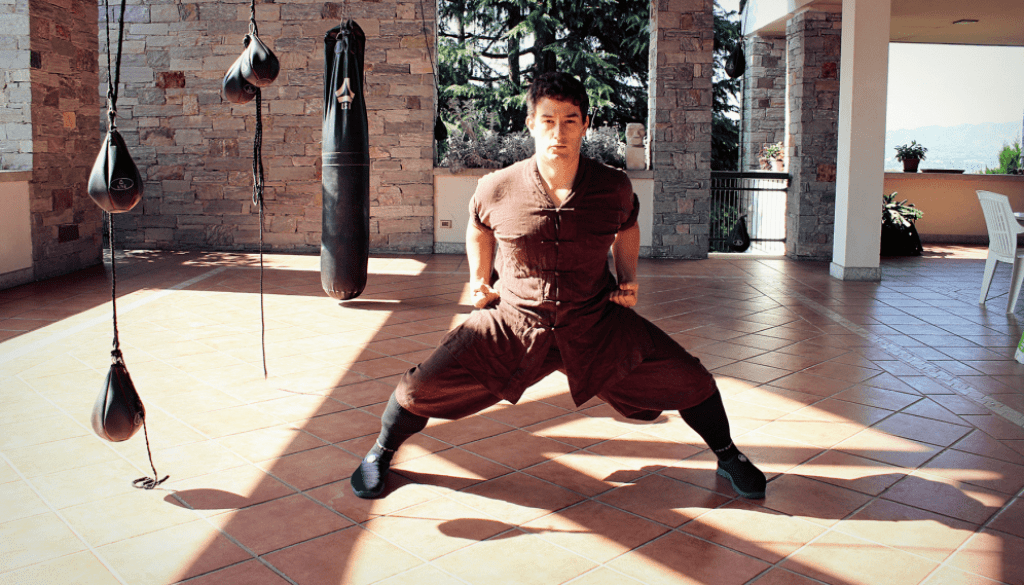Kung Fu rooting: the pyramid concept
What is rooting in Kung Fu?
The 2 crucial aspects related to rooting
In 6 Dragons Kung Fu, when we talk about rooting (as in Tai Chi or Wing Chun) we refer substantially to two things:
- Resist – The ability to resist the opponent’s interaction (thrusts, projections, etc.) without losing balance
- Express power – The ability to express the full potential of our body power (punches, constrictions, etc.) avoiding any dispersion of force
Note – This article has been asked by one of our Core Course practitioners on Patreon (see how to attend our home study classes here Learn Kung Fu online: a beginner-to-expert course).
The concept of the body pyramid
The first step to gain these skills is to imagine our body as inscribed in a pyramid where:
- The head is the tip
- The feet are the base
A note by Master Kongling – It does not matter what stance we are adopting: we have always to think this way: only when we begin to identify our body as a pyramid we will start to understand how to increase its stability.
The main (and most simple) factors that can boost our body balance (read How to improve balance: tricks and exercises) are:
- The support area
- The tip of the pyramid
- The center of gravity
How to easily improve our rooting
A few easy tips to improve our rooting
To drastically and effortlessly increase our rooting we can simply:
- Enlarge the support area – Size, weight, position and shape of the leaning area (generally the feet and the space between them) are fundamental factors that influence our stability
- Rotate the pyramid support – The support area of our pyramid (eg. the feet) must be positioned, in relation to the opponents, in such a way that will make it harder for them to move us (pull, push, throw, etc., we will deepen this)
- Align the tip of the pyramid – If the tip of the pyramid (generally the head) is aligned to the center of gravity and to the support point we will generally have a better rooting
- Lower our combat position – The more our center of gravity is low and the more stable we are (that is why the Kung Fu, for example, of the northern Shaolin monks, is characterized by very low stances, read
This, naturally, is not everything but it is all we can do without:
- Training
- Experience
- Deep knowledge of rooting theory
A step forward
To simply add something more to what we said, we can:
- Start to strengthen our muscles (especially the legs) with the exercises described in “How to improve balance: tricks and exercises”
- Build good standing stamina (practicing the various Kung Fu stances, read Standing stamina: what is and its development, The correct position of the rider (ma bu) and Training for balance / rooting: feet on tires)
Final notes
In conclusion, it is obvious that:
- The advice exposed will result in a significant improvement of our static balance but that is not sufficient, there is much more to do (we will see everything with time)
- If, for example, we cannot balance ourselves on one foot when we are alone and relaxed, we will never be able to develop the subsequent rooting-related abilities
- The advice given in this article should not be used during the whole evolution of a confrontation but only when necessity imposes it (our body structure must adapt instinctively to each situation, read 6DKF’s interactions: from the strong blow to the light touch); there are moments where being in a too low stance is a disadvantage
- Our rooting must be calibrated with our athletic possibilities; lowering the stance and enlarging its base gives more stability but if we are not conditioned to perform explosive movements, we will have extremely reduced mobility
- In combat, having limited mobility is (almost always) more dangerous than not having good rooting (the use of truly low stances requires hours and hours of daily training)
- Finally, it must be said that the lower postures, if we are not used to maintaining them, unnecessarily consume more energy than the higher ones; the advice is to find the right middle ground
- …
In the next article of this series, we will continue to explain the concepts related to rooting in 6 Dragons Kung Fu.
In-depth video courses
- Basic Kung Fu stances: how to – A visual and detailed explanation of the basic Kung Fu positions
- Static and dynamic balance: how to – A video course specifically focused on the development of balance
- Basic 6 Dragons Kung Fu Exercises – The base to build real martial skills (first of all balance)
In-depth articles
- How to rapidly learn Kung Fu: guard stance – How to sketch an effective fighting stance
- An exercise for balance with medicine ball – A good exercise to develop balance (intermediate level)
Questions
Reply in the comments and share your experience:
- What is your ideal combat height?
Author: Master Kongling
Founder of 6 Dragons Kung Fu.How to master 6 Dragons Kung Fu?
Are you searching for:
- Daily training exercises?
- Synthetic theory and concepts?
- A step by step path from white to black belt?
- A path (clear, consequential and gradual) designed to build real martial skills?
- A direct contact with Master Kongling?
Go to our Patreon page and choose a training plan: starting from the Practitioner level, you will gain access to all this and much more.
Inside each Premium Lesson, you will receive the same teaching (practices, tips, concepts, small secrets and corrections) reserved to the live students of Master Kongling.
Important - Once a certain number of registrations are reached, no other participants can be accepted. For more information write to: [email protected].











September 22, 2018 @ 5:50 pm
How much low are the Shaolin postures?
September 24, 2018 @ 10:18 am
Thighs parallel to the ground
June 26, 2019 @ 10:52 am
I think this is a cornerstone principle
June 28, 2019 @ 1:50 pm
Yes, it is.
July 20, 2022 @ 1:35 pm
I am a grappler, so I love to stay very bent throughout the fight.
November 20, 2023 @ 2:34 am
knee bent!
November 20, 2023 @ 11:20 pm
😉